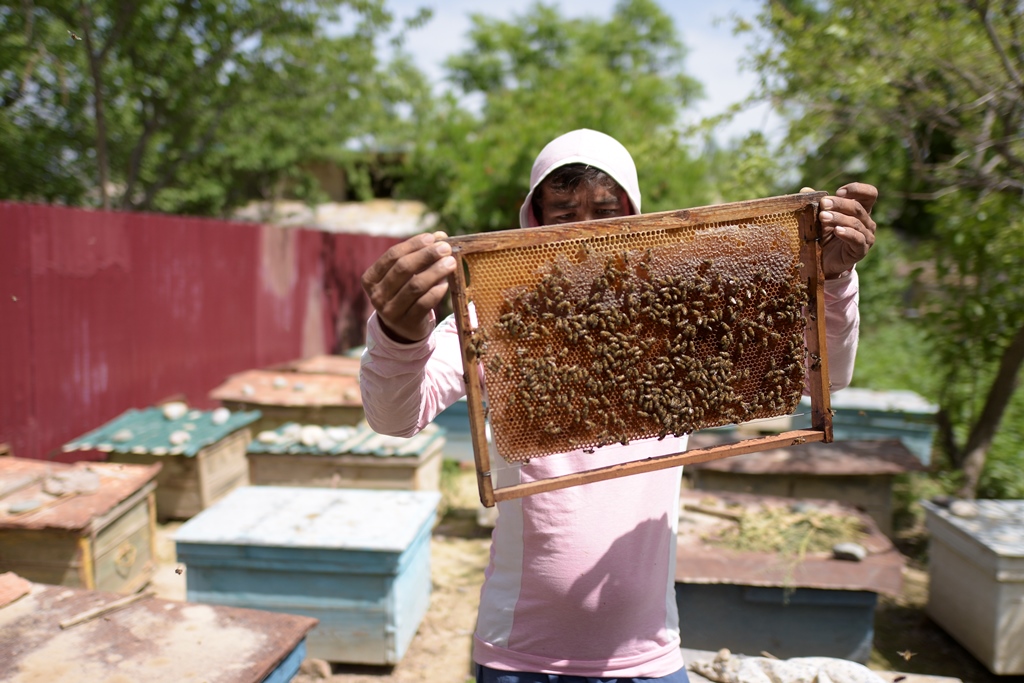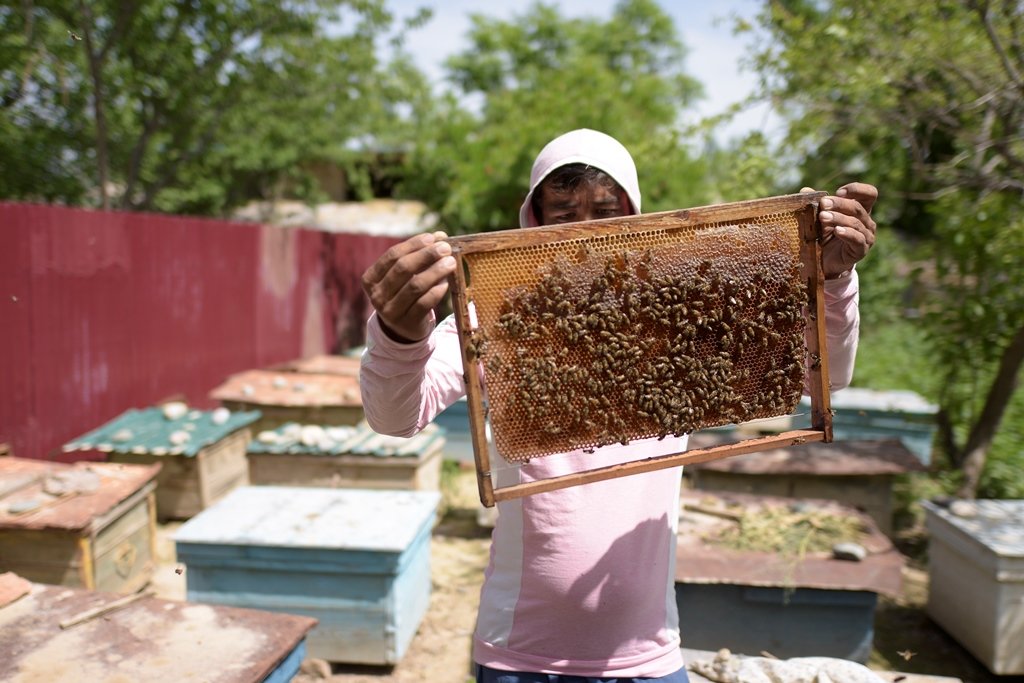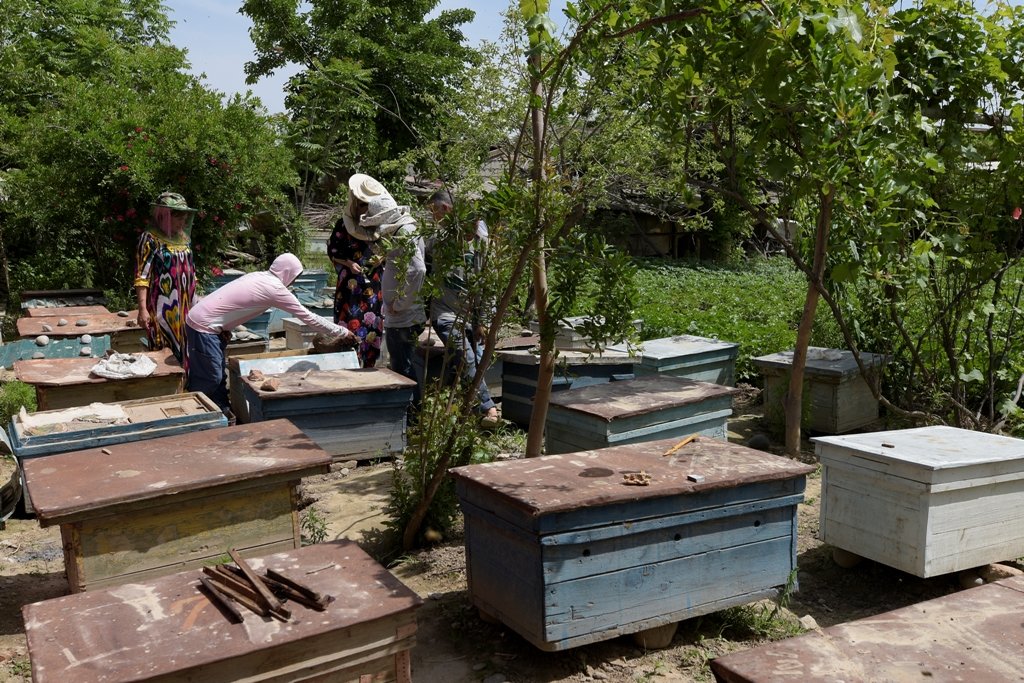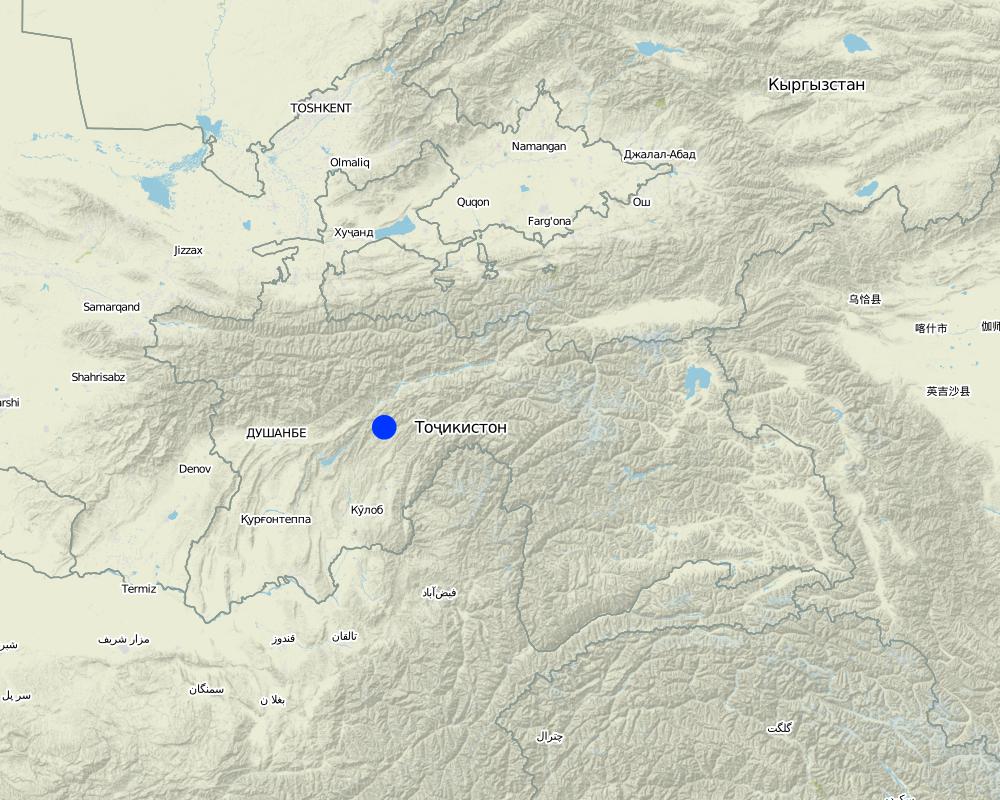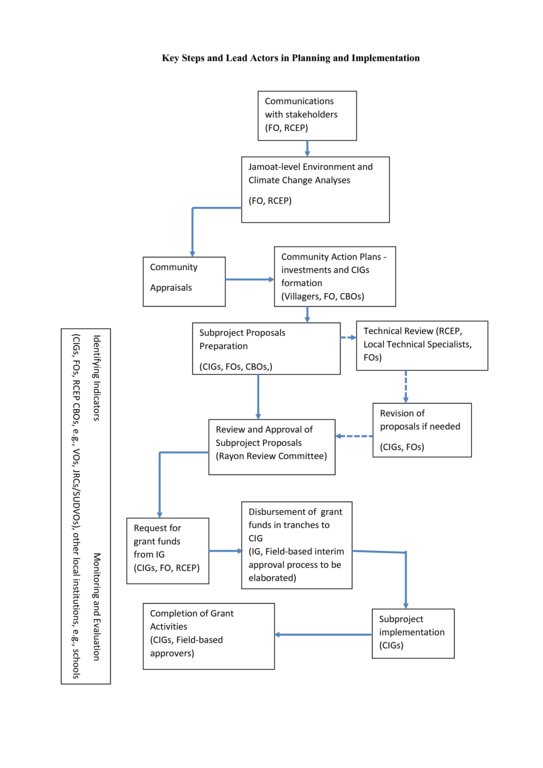Improving productivity of fruit trees through development beekeeping sector [ប្រទេសតាហ្ស៊ីគីស្ថាន]
- ការបង្កើត៖
- បច្ចុប្បន្នភាព
- អ្នកចងក្រង៖ Kamolidin Abdulloev
- អ្នកកែសម្រួល៖ –
- អ្នកត្រួតពិនិត្យ Farrukh Nazarmavloev
Бехтар намудани самарраи дарахтони мевадиханда таввасути занбурпарвари
approaches_3887 - ប្រទេសតាហ្ស៊ីគីស្ថាន
ពិនិត្យមើលគ្រប់ផ្នែក
ពង្រីកមើលទាំងអស់ បង្រួមទាំងអស់1. ព័ត៌មានទូទៅ
1.2 ព័ត៌មានលម្អិតពីបុគ្គលសំខាន់ៗ និងស្ថាប័នដែលចូលរួមក្នុងការវាយតម្លៃ និងចងក្រងឯកសារនៃវិធីសាស្ត្រផ្សព្វផ្សាយ
បុគ្គលសំខាន់ម្នាក់ (ច្រើននាក់)
អ្នកជំនាញឯកទេស SLM:
ឈ្មោះគម្រោងដែលបានចងក្រងឯកសារ/ វាយតម្លៃលើវិធីសាស្ត្រផ្សព្វផ្សាយ (បើទាក់ទង)
Environmental Land Management and Rural Livelihoods (ELMAR)ឈ្មោះអង្គភាពមួយ (ច្រើន) ដែលបានចងក្រងឯកសារ/ វាយតម្លៃលើវិធីសាស្ត្រផ្សព្វផ្សាយ (បើទាក់ទង)
Committee for Environment Protection of Tajikistan (Committee for Environment Protection of Tajikistan) - ប្រទេសតាហ្ស៊ីគីស្ថាន1.3 លក្ខខណ្ឌទាក់ទងទៅនឹងការប្រើប្រាស់ទិន្នន័យដែលបានចងក្រងតាមរយៈវ៉ូខេត
តើពេលណាដែលទិន្នន័យបានចងក្រង (នៅទីវាល)?
22/06/2018
អ្នកចងក្រង និង(បុគ្គលសំខាន់ៗ)យល់ព្រមទទួលយកនូវលក្ខខណ្ឌនានាទាក់ទងទៅនឹងការប្រើប្រាស់ទិន្នន័យដែលបានចងក្រងតាមរយៈ វ៉ូខេត:
បាទ/ចា៎
2. ការពណ៌នាអំពីវិធីសាស្ត្រផ្សព្វផ្សាយ SLM
2.1 ពណ៌នាសង្ខេបខ្លីពីវិធីសាស្ត្រផ្សព្វផ្សាយ
Honeybee keeping improves pollination of trees, shrubs, and crops, which will increase the productivity of orchards, arable lands, grassland
2.2 ពណ៌នាលម្អិតពិវិធីសាស្ត្រផ្សព្វផ្សាយ
ពណ៌នាលម្អិតពិវិធីសាស្ត្រផ្សព្វផ្សាយ:
Beekeeping provides an opportunity to improve the economic use and ecosystem sanitation in the future. On the one hand, honeybee keeping improves pollination of trees, shrubs and crops, which will increase the productivity of orchards, arable lands, grassland and highland areas also households got high-quality honey and income. In addition, an approach is supporting households using the existing natural features, population improved their living standards by increasing the production of environmentally sound and high-quality honey, then sold at local markets.
Shaidon village has 238 households and 1651 people are living. Shaidon village is located at a distance of 35 km from the district center. According to statistics, the area of land used in the village is 886 hectares. Of these, 60 hectares are household plots, 26 hectares are private farms and 800 hectares occupy pastures. The population is engaged in breeding 470 heads of neat cattle, 520 heads of small cattle, 5 horses, 120 donkeys, 460 chickens and 60 turkeys. On average, each household has 0.08 ha of plots. The soil in the village is included in the category of gray soil. The annual rainfall in the village is up to 700 mm. Winter lasts for 3 months. The terrain is flat, the source of drinking water is groundwater and natural water resources.
An approach supported on behalf of the ELMARL Project. Shaidon village has expanded and favorable opportunities for the development of the beekeeping sector. and bee families were provided to 25 households that are the CIG members. And the CIG members considers that it necessary to strengthen the productivity of fruit trees in the village, through the development of beekeeping sector, as the result provided bee colonies (hives), appropriate uniforms and supplies, wax and medicines, so that ensure the production of ecologically pure honey, the appearance of additional income and new working places. Farmers have purchased the following units under the Project: 25 hives, 25 bee colonies, 1 pc. smothe king device, 1 pc. special device for collecting honey, 15 pcs. protective clothing, 150 kg of sugar and medicines the purchase of which as well transportation of hives and bee families from Khatlon region were funded by the Project. Arrangement, moving and care of bees is assigned to the farmers.
2.3 រូបភាពនៃវិធីសាស្ត្រផ្សព្វផ្សាយ
កំណត់សំគាល់ទូទៅរបស់រូបថត:
Shaidon village has expanded and favorable opportunities for the development of the beekeeping sector
2.5 ប្រទេស/តំបន់/ទីតាំងកន្លែង ដែលវិធីសាស្ត្រផ្សព្វផ្សាយត្រូវបានអនុវត្តន៍
ប្រទេស:
ប្រទេសតាហ្ស៊ីគីស្ថាន
តំបន់/រដ្ឋ/ខេត្ត:
Kulob Region, Baljuvon District
បញ្ជាក់បន្ថែមពីលក្ខណៈនៃទីតាំង:
Sari Khosor jamoat, Shaidon village
មតិយោបល់:
The approach will be implemented in the Shaidon village
Map
×2.6 កាលបរិច្ឆេទនៃការចាប់ផ្តើម និងបញ្ចប់នៃវិធីសាស្រ្តផ្សព្វផ្សាយនេះ
សូមបញ្ជាក់ឆ្នាំដែលបានបង្កើតឡើង:
2016
ឆ្នាំបញ្ចប់ (ប្រសិនបើវិធីសាស្ត្រផ្សព្វផ្សាយត្រូវបានឈប់ប្រើប្រាស់):
2017
មតិយោបល់:
This approach has been implemented on a project base and during the 2 years monitored and controlled. The CIG gives this responsibility and will manage and maintain it in future
2.7 ប្រភេទនៃវិធីសាស្ត្រផ្សព្វផ្សាយ
- ផ្អែកលើគម្រោង/កម្មវិធី
2.8 គោលបំណង/ទិសដៅសំខាន់នៃវិធីសាស្ត្រផ្សព្វផ្សាយ
Enhancing productivity of the orchards, arable lands, grassland and highland areas and improve the economic use and ecosystem sanitation in the future by developing beekeeping
2.9 លក្ខខណ្ឌអនុញ្ញាត ឬរារាំងការអនុវត្តន៍បច្ចេកទេសដែលស្ថិតនៅក្រោមវិធីសាស្រ្តផ្សព្វផ្សាយ
សង្គម/វប្បធម៌/ និងតម្លៃនៃសាសនា
- អំណោយផល
Before the project people besides the income did not think about the other issues like environment and productiveness of the orchards and agriculture lands
Proposed approach change their minds to think broader, through supporting them with the training and also beekeeping equipment
ភាពអាចរកបាននៃធនធានហិរញ្ញវត្ថុ និងសេវាកម្ម
- អំណោយផល
For now not
But in the near future, they will have the opportunity for the availability of the income, as the group trying to increase the number of the beehives.
បរិបទនៃស្ថាប័ន
- អំណោយផល
The CIG group is formed and will manage and maintain the approach
ចំណេះដឹងស្តីពី SLM និងការទទួលបានការគាំទ្រផ្នែកបច្ចេកទេស
- រារាំង
Lack of knowledge on SLM approaches and technologies
Organised and provided the different type of SLM relative trainings on behalf of the project but iy is steel an issue
3. ការចូលរួម និងតួនាទីរបស់ភាគីពាក់ព័ន្ធ
3.1 អ្នកពាក់ព័ន្ធដែលបានចូលរួមក្នុងវិធីសាស្ត្រផ្សព្វផ្សាយ និងតួនាទីរបស់ពួកគេ
- អ្នកប្រើប្រាស់ដីក្នុងតំបន់/សហគមន៍
CIG members (local farmers)
Local farmers prioritized investments based on a fixed budget for each type of rural investment determined by the number of households. Within a plan of action, participants decided on the allocation of investments to groups of households using rules that limit the funding for any one household.
All activities, including PRA, training and investment subprojects involved men and women with due a diligence. Social safety was assured for the people with disabilities, who participated in rural livelihoods activities and had equal rights and voices.
- អ្នកឯកទេសគ្រប់គ្រងដីប្រកបដោយចីរភាព/ទីប្រឹក្សាបច្ចេកទេសកសិកម្ម
Facilitating organizations and academy of science
Representatives from the facilitating organizations and professors (as TOT trainers) from the Institutions and academies involved during the training
- រដ្ឋាភិបាលថ្នាក់មូលដ្ឋាន
Jamoat representative, Hukumat of the district departments
Jamoat representatives were involved in Participatory Rural Appraisal (PRA) that was used as the main pre-assessment mechanism to analyze the socio-economic and environmental situation in the selected pilots,
The RRC(Rayon Review Committee) will consider the combination of proposed sub-projects within the overall context of the rayon and project. The committee will review and accept proposals that meet project guidelines and provide clearance to the Project Staff for the release of project funding to the accounts of relevant CIGs.
3.2 ការចូលរួមរបស់អ្នកប្រើប្រាស់ដីក្នុងតំបន់/ សហគមន៍ក្នុងតំបន់ក្នុងដំណាក់កាលផ្សេងគ្នានៃវិធីសាស្រ្តផ្សព្វផ្សាយ
| ការចូលរួមរបស់អ្នកប្រើប្រាស់ដីក្នុងតំបន់/សហគមន៍ក្នុងតំបន់ | សូមបញ្ជាក់នរណាត្រូវបានចូលរួម ព្រមទាំងពណ៌នាសកម្មភាពទាំងនោះ | |
|---|---|---|
| ការរៀបចំផែនការ | អសកម្ម | Project beneficiaries (CIG Members) interviewed and consulted during the social assessment conducted in the project design process which then influenced project approaches. |
| ការអនុវត្តន៍ | អន្តរកម្ម | Villagers (CIG Members) made grant allocation decisions. CIGs managed grant funds and purchased needed materials and products individually |
| ការត្រួតពិនិត្យ និងវាយតម្លៃ | អសកម្ម | CIGs participated during the monitoring activity |
3.3 គំនូសបំព្រួញ (ប្រសិនបើមាន)
ការពណ៌នា:
Here is the key steps and actors in the planning and implementation of rural investments. Not all possible participants in these steps are included since local situations may vary and will need to be taken into account during planning and implementation.
អ្នកនិពន្ធ:
ELMARL POM
3.4 ការសម្រេចចិត្តលើការជ្រើសរើសបច្ចេកទេស SLM
សូមបញ្ជាក់តើអ្នកណាជាអ្នកបានសម្រេចចិត្តក្នុងការជ្រើសរើសបច្ចេកទេសដើម្បីយកមកអនុវត្តន៍:
- អ្នកប្រើប្រាស់ដី ដោយមានការគាំទ្រពីអ្នកជំនាញឯកទេស SLM
ចូរពន្យល់:
Villagers prioritized investments based on a fixed budget for each type of rural investment determined by the number of households. Within a plan of action, participants decided on the allocation of investments to groups of households (Common Interest Groups, CIGs) using rules that limit the funding for any one household.
សូមបញ្ជាក់ តើការសម្រេចធ្វើឡើងដោយផ្អែកលើអ្វីជាមូលដ្ឋាន:
- វាយតម្លៃទៅលើចំណេះដឹងស្តីអំពី SLM ដែលបានចងក្រងជាឯកសារបានត្រឹមត្រូវ (ផ្អែកលើភស្តុតាងជាមូលដ្ឋានដើម្បីសម្រេចចិត្ត)
4. ជំនួយបច្ចេកទេស ការកសាងសមត្ថភាព និងការគ្រប់គ្រងចំណេះដឹង
4.1 ការកសាងសមត្ថភាព/ បណ្តុះបណ្តាល
តើវគ្គបណ្តុះបណ្តាលបានផ្តល់ឱ្យអ្នកប្រើប្រាស់ដី/អ្នកពាក់ព័ន្ធផ្សេងៗទៀតដែរឬទេ?
បាទ/ចា៎
សូមបញ្ជាក់តើអ្នកណាត្រូវបានបណ្តុះបណ្តាល:
- អ្នកប្រើប្រាស់ដី
- បុគ្គលិកចុះទីវាល/អ្នកផ្តល់ប្រឹក្សាយោបល់
ប្រសិនទាក់ទង សូមបញ្ជាក់ ភេទ អាយុ ស្ថានភាពគ្រួសារ ជនជាតិដើមភាគតិច។ល។:
Specialists from the FOs used mechanisms that provided full participation, women, and men in all sessions
ទម្រង់នៃការបណ្តុះបណ្តាល:
- អនុវត្តន៍ជាមួយការងារ
- ពីកសិករទីកសិករ
ប្រធានបទបណ្តុះបណ្តាល:
Grant allocation mechanisms. Fund flow arrangements, management and technical, SLM training
មតិយោបល់:
Training included such king themes;
composting, mulching, managing salinization, intercropping on slopes, drip irrigation, low-cost watering techniques, solar greenhouses, drought-resistant crops, bee-keeping, mixed fruit orchards, local varieties nurseries, rotational grazing, Livestock breeding and maintaining, strategic watering points, use of perennial forage, solar energy technologies, marketing options and opportunities
4.2 សេវាផ្តល់ប្រឹក្សាយោបល់
តើអ្នកប្រើប្រាស់ដីបានទទួលនូវសេវាផ្តល់ប្រឹក្សាដែរ ឬទេ?
បាទ/ចា៎
សូមបញ្ជាក់ប្រសិនបើសេវាកម្មប្រឹក្សាយោបល់ត្រូវបានផ្តល់ឱ្យ:
- នៅមជ្ឈមណ្ឌលជាអចិន្ត្រៃ
ពណ៌នា/ពន្យល់:
Jamoat reprezentatives advise CIG members and support them in realisation their plans
4.3 ការពង្រឹងសមត្ថភាពស្ថាប័ន (ការអភិរឌ្ឍន៍អង្គភាព)
តើស្ថាប័នទាំងអស់ត្រូវបានបង្កើតឡើង ឬពង្រឹងសមត្ថភាពតាមរយៈវិធីសាស្ត្រផ្សព្វផ្សាយដែរ ឬទេ?
- បាទ/ច៎ា តិចតួច
សូមបញ្ជាក់ថាតើស្ថាប័នត្រូវបានពង្រឹង ឬបង្កើតឡើងនៅត្រឹមកម្រិតណា(ច្រើន)?
- ថ្នាក់មូលដ្ឋាន
ចូពណ៌នាពីស្ថាប័ន តួនាទី និងទំនួលខុសត្រូវ សមាជិក ។ល។:
The Common Interest Groups formed in the villages on behalf households and enhanced their knowledge. And the project provides small-scale grants at the village level for groups of households (CIG) to implement rural production and land management investments, as well as related small-scale infrastructure investments. Villages prioritized investments based on a fixed budget for each type of rural investment, determined by the number of households.
សូមបញ្ជាក់ប្រភេទនៃការគាំទ្រ:
- ហិរញ្ញវត្ថុ
- ការកសាងសមត្ថភាព/ បណ្តុះបណ្តាល
សូមផ្តល់ព័ត៌មានបន្ថែមទៀតឱ្យបានលម្អិត:
Project-financed grants to CIGs for each investment under categories of rural production and land management investments, as well as related small-scale infrastructure investments that will not exceed US$7,000 and will require a match of 25% in beneficiary contributions which may be in cash or in-kind
4.4 ការត្រួតពិនិត្យ និងវាយតម្លៃ
តើការត្រួតពិនិត្យ និងវាយតម្លៃគឺជាផ្នែកមួយនៃវិធីសាស្ត្រដែរឬទេ?
បាទ/ចា៎
មតិយោបល់:
Grant allocation, number of beneficiaries, Estimated costs of rural investments, environmental aspects, management of the investments
ប្រសិន បាទ/ច៎ា តើឯកសារនេះបានបង្កើតឡើងក្នុងគោលបំណងប្រើប្រាស់សម្រាប់ការត្រួតពិនិត្យ និងវាយតម្លៃដែរឬទេ?
បាទ/ចា៎
មតិយោបល់:
Rural investment monitoring should focus on the range of issues relevant to subproject sustainability, including environmental, social and economic. FOs build CIG capacities to monitor these aspects and to adapt to changing conditions.
4.5 ការស្រាវជ្រាវ
តើការស្រាវជ្រាវ គឺជាផ្នែកមួយនៃវិធីសាស្រ្តដែរឬទេ?
ទេ
5. ថវិកា និងសម្ភារៈឧបត្ថម្ភពីខាងក្រៅ
5.1 ថវិកាប្រចាំឆ្នាំសម្រាប់ផ្សព្វផ្សាយ SLM
ប្រសិនបើចំនួនពិតប្រាកដនៃថវិកាប្រចាំឆ្នាំមិនត្រូវបានដឹងច្បាស់ សូមប្រាប់ពីចន្លោះនៃថវិកានោះ:
- 2,000-10,000
មតិយោបល់ (ឧ. ប្រភពសំខាន់នៃមូលនិធិ/ម្ចាស់ជំនួយចំបង):
GEF/PPCR through WB
5.2 ការគាំទ្រផ្នែកហិរញ្ញវត្ថុ / សម្ភារៈដែលបានផ្តល់ទៅឱ្យអ្នកប្រើប្រាស់ដី
តើអ្នកប្រើប្រាស់ដីបានទទួលការគាំទ្រផ្នែកហិរញ្ញវត្ថ/សម្ភារៈសម្រាប់ការអនុវត្តន៍បច្ចេកទេសដែរឬទេ:
បាទ/ចា៎
ប្រសិនបាទ/ច៎ា សូមបញ្ជាក់ប្រភេទ(ច្រើន)នៃការគាំទ្រ លក្ខខណ្ឌ និងអ្នកផ្តល់ឱ្យ(ច្រើន):
The project provided small-scale grants at the village level for groups of households to implement rural production and land management investments, as well as related small-scale
infrastructure investments.Villages prioritized investments based on a fixed budget for each type of rural investment, determined by the number of households.
Mechanism: The Common Interest Groups formed at village level on behalf of households and enhanced their knowledge. Further project financed CIG with the small grants under the three main categories of activities that are expected to contribute to their assets and sustainable land management, and increase climate resilience.
An approach/subproject been supported grant amount 7,000 USD and implemented through the Common Interest Group (CIG). CIG have contributed more then 25% from the total approach/subproject amount.
5.3 សូមបញ្ជាក់ពីធាតុចូលត្រូវបានផ្តល់បដិភាគ (រួមទាំងកម្លាំងពលកម្ម)
- គ្មាន
ប្រសិនបើកម្លាំងពលកម្មធ្វើដោយអ្នកប្រើប្រាស់ដី តើវាជាធាតុចូលដ៏សំខាន់មួយដែរ ឬទេ:
- ដោយស្ម័គ្រចិត្ត
មតិយោបល់:
As mentioned above beneficiary contribution was in-kind the 25% of the total subproject amount
5.4 ឥណទាន
តើឥណទានដែលបានផ្តល់នៅក្រោមវិធីសាស្ត្រផ្សព្វផ្សាយសម្រាប់សកម្មភាព SLM នេះយ៉ាងដូចម្តេច?
ទេ
5.5 ការលើកទឹកចិត្ត ឬវិធីសាស្ត្រដ៏ទៃទៀត
តើមានការលើកទឹកចិត្តផ្សេងទៀត ឬឧបករណ៍ប្រើប្រាស់ដើម្បីលើកកម្ពស់ការអនុវត្តន៍បច្ចេកទេស SLM?
បាទ/ចា៎
បើបាទ/ចា៎ សូមបញ្ជាក់:
Study tours, competition farmer to farmer
6. ការវិភាគរកផលប៉ះពាល់ និងសេចក្តីសន្និដ្ឋាន
6.1 ផលប៉ះពាល់នៃវិធីសាស្ត្រផ្សព្វផ្សាយ
As a result of the approach, mainly households got high-quality honey, and 25 households got jobs. On the other hand, using the existing natural features, population improved their living standards by increasing the production of environmentally sound and high-quality honey, then sold at local markets. In addition productivity will be increased from the fruit trees and also agriculture lands that will be another income to the local land users.
តើវិធីសាស្ត្រផ្សព្វផ្សាយជួយអ្នកប្រើប្រាស់ដីដើម្បីអនុវត្តន៍ និងថែទាំបច្ចេកទេស SLM?
- ទេ
- បាទ/ច៎ា បន្តិចបន្តួច
- បាទ/ច៎ា ជាមធ្យម
- បាទ/ច៎ា បានខ្លាំង
During the project implementation training and meetings were organized with the CIG (local people) that will give them the opportunity to manage and maintain on hand approach
តើវិធីសាស្ត្រផ្សព្វផ្សាយនេះធ្វើឱ្យចំណេះដឹងប្រសើឡើង និងសមត្ថភាពរបស់អ្នកប្រើប្រាស់ដីក្នុងការអនុវត្តន៏ SLM?
- ទេ
- បាទ/ច៎ា បន្តិចបន្តួច
- បាទ/ច៎ា ជាមធ្យម
- បាទ/ច៎ា បានខ្លាំង
All the trainings (composting, mulching, managing salinization, intercropping on slopes, drip irrigation, low-cost watering techniques, solar greenhouses, drought-resistant crops, bee-keeping, mixed fruit orchards, local varieties nurseries, rotational grazing, Livestock breeding and maintaining, strategic watering points, use of perennial forage) that have provided during the project implementation linked somehow to the SLM. And CIG members trying all their best to increase the number of the beehives and expand approach among other villagers
6.2 ការលើកទឹកចិត្តចម្បងៗរបស់អ្នកប្រើប្រាស់ដីសម្រាប់ការអនុវត្តបច្ចេកទេស SLM
- បង្កើនផលិតកម្ម
Villagers have expanded and favorable opportunities for the development of beekeeping sector as honeybee keeping improves pollination of trees, shrubs, and crops, which will increase the productivity of orchards, arable lands, grassland and highland areas.a
- លើកកម្ពស់ចំណេះដឹង និងជំនាញ SLM
Villagers have expanded and favorable opportunities for the development of beekeeping sector as honeybee keeping improves pollination of trees, shrubs, and crops, which will increase the productivity of orchards, arable lands, grassland and highland areas.
6.3 សកម្មភាពផ្សព្វផ្សាយដែលប្រកបដោយចីរភាព
តើអ្នកប្រើប្រាស់ដីអាចធ្វើឱ្យមានចីរភាពនូវអ្វីដែលត្រូវបានអនុវត្តន៍តាមរយៈវិធីសាស្ត្រផ្សព្វផ្សាយដែរឬទេ(ដោយពុំមានការគាំទ្រពីអ្នកខាងក្រៅ)?
- បាទ/ចា៎
ប្រសិនបាទ/ច៎ា សូមរៀបរាប់ថាធ្វើយ៉ាងម៉េច:
Because before starting of the project "participatory rural appraisal" within ELMARL project was the first steps to the sustainability because the villagers identify and prioritize development needs. This meaning that from the beginning villagers involved and even by them made grant allocation decisions, also CIGs managed grant funds and bought inputs.. Maintaining actions are in place
6.4 ភាពខ្លាំង/ គុណសម្បត្តិនៃវិធីសាស្ត្រផ្សព្វផ្សាយ
| ភាពខ្លាំង/ គុណសម្បត្តិ/ ឱកាស ទស្សនៈរបស់អ្នកប្រើប្រាស់ដី |
|---|
| Sufficient climate of the place and experianced CIG specialists is the garanty of the activity and sustainibility of the approach |
| ភាពខ្លាំង/ គុណសម្បត្តិ/ ឱកាស ទស្សនៈរបស់បុគ្គលសំខាន់ៗ |
|---|
| Collecting people in one Group(CIG), gives opportunity to do desicions together and expanding approach in the plan |
| Capacity building events that was organised during the approach, new technologies, new knowledges and so on |
| Good cooperation with the jamoat |
6.5 ភាពខ្សោយ/ គុណវិបត្តិនៃវិធីសាស្ត្រ និងរកដំណោះស្រាយ
| ភាពខ្សោយ/ គុណវិបត្តិ/ ហានិភ័យ ទស្សនៈរបស់អ្នកប្រើប្រាស់ដី | តើបច្ចេកទេសទាំងនោះបានដោះស្រាយបញ្ហាដូចម្តេច? |
|---|---|
| Bees diseases | Needs more training and support on behalf of the district hukumat and projects |
| ភាពខ្សោយ/ គុណវិបត្តិ/ ហានិភ័យក្នុងទស្សនៈរបស់បុគ្គលសំខាន់ៗ | តើបច្ចេកទេសទាំងនោះបានដោះស្រាយបញ្ហាដូចម្តេច? |
|---|---|
| Market, value chance, preparation of the business plans and other reletive knowledges they need | Other coming projects or local hukumat needs to support them |
7. ឯកសារយោង និងវេបសាយ
7.1 វិធីសាស្ត្រ/ ប្រភពនៃព័ត៌មាន
- ការចងក្រងពីរបាកការណ៍ និងឯកសារផ្សេងៗទៀតដែលមាន
Existed project documents and reports
7.2 ឯកសារយោងដែលបានចេញផ្សាយ
ចំណងជើង អ្នកនិពន្ធ ឆ្នាំ ISBN:
ELMARL Annual Report 2017
មានប្រភពមកពីណា? ថ្លៃដើមប៉ុន្មាន?
CEP of RT, free
7.3 ចូលទៅទាញយកឯកសារពាក់ព័ន្ធដែលមានលើបណ្តាញអ៊ិនធឺណែត
ចំណងជើង/ ពណ៌នា:
ELMARL Annual Report 2017
ការតភ្ជាប់ និងម៉ូឌុល
ពង្រីកមើលទាំងអស់ បង្រួមទាំងអស់ការតភ្ជាប់
គ្មានការតភ្ជាប់
ម៉ូឌុល
គ្មានម៉ូឌុល


